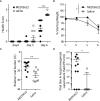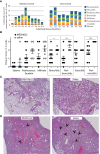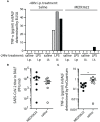An ADAM17-Neutralizing Antibody Reduces Inflammation and Mortality While Increasing Viral Burden in a COVID-19 Mouse Model
- PMID: 35757773
- PMCID: PMC9226444
- DOI: 10.3389/fimmu.2022.918881
An ADAM17-Neutralizing Antibody Reduces Inflammation and Mortality While Increasing Viral Burden in a COVID-19 Mouse Model
Abstract
Angiotensin Converting Enzyme 2 (ACE2) is the primary cell entry receptor for SARS-CoV and SARS-CoV-2 viruses. A disintegrin and metalloproteinase 17 (ADAM17) is a protease that cleaves ectodomains of transmembrane proteins, including that of ACE2 and the proinflammatory cytokine TNF-α, from cell surfaces upon cellular activation. We hypothesized that blockade of ADAM17 activity would alter COVID-19 pathogenesis. To assess this pathway, we blocked the function of ADAM17 using the monoclonal antibody MEDI3622 in the K18-hACE2 transgenic mouse model of COVID-19. Antibody-treated mice were healthier, less moribund, and had significantly lower lung pathology than saline-treated mice. However, the viral burden in the lungs of MEDI3622-treated mice was significantly increased. Thus, ADAM17 appears to have a critical anti-viral role, but also may promote inflammatory damage. Since the inflammatory cascade is ultimately the reason for adverse outcomes in COVID-19 patients, there may be a therapeutic application for the MEDI3622 antibody.
Keywords: ADAM19; COVID-19; SARS-CoV-2; inflammation; lung; mouse model; virus.
Copyright © 2022 Hedges, Snyder, Robison, Grifka-Walk, Blackwell, Shepardson, Kominsky, Rynda-Apple, Walcheck and Jutila.
Conflict of interest statement
The authors declare that the research was conducted in the absence of any commercial or financial relationships that could be construed as a potential conflict of interest.
Figures




Similar articles
-
Human convalescent plasma protects K18-hACE2 mice against severe respiratory disease.J Gen Virol. 2021 May;102(5):001599. doi: 10.1099/jgv.0.001599. J Gen Virol. 2021. PMID: 33961540 Free PMC article.
-
SARS-CoV-2 Causes Lung Infection without Severe Disease in Human ACE2 Knock-In Mice.J Virol. 2022 Jan 12;96(1):e0151121. doi: 10.1128/JVI.01511-21. Epub 2021 Oct 20. J Virol. 2022. PMID: 34668780 Free PMC article.
-
The K18-Human ACE2 Transgenic Mouse Model Recapitulates Non-severe and Severe COVID-19 in Response to an Infectious Dose of the SARS-CoV-2 Virus.J Virol. 2022 Jan 12;96(1):e0096421. doi: 10.1128/JVI.00964-21. Epub 2021 Oct 20. J Virol. 2022. PMID: 34668775 Free PMC article.
-
Interactions of renin-angiotensin system and COVID-19: the importance of daily rhythms in ACE2, ADAM17 and TMPRSS2 expression.Physiol Res. 2021 Dec 16;70(S2):S177-S194. doi: 10.33549/physiolres.934754. Physiol Res. 2021. PMID: 34913351 Free PMC article. Review.
-
The basis of complications in the context of SARS-CoV-2 infection: Pathological activation of ADAM17.Biochem Biophys Res Commun. 2023 Oct 30;679:37-46. doi: 10.1016/j.bbrc.2023.08.063. Epub 2023 Aug 31. Biochem Biophys Res Commun. 2023. PMID: 37666046 Review.
Cited by
-
Unveiling the Interplay-Vitamin D and ACE-2 Molecular Interactions in Mitigating Complications and Deaths from SARS-CoV-2.Biology (Basel). 2024 Oct 16;13(10):831. doi: 10.3390/biology13100831. Biology (Basel). 2024. PMID: 39452140 Free PMC article. Review.
-
Strain- and vaccine-specific effects of serum antibodies in the protection of intestinal SARS-CoV-2 infection.medRxiv [Preprint]. 2025 Mar 28:2025.03.24.25324570. doi: 10.1101/2025.03.24.25324570. medRxiv. 2025. PMID: 40196264 Free PMC article. Preprint.
-
JG26 attenuates ADAM17 metalloproteinase-mediated ACE2 receptor processing and SARS-CoV-2 infection in vitro.Pharmacol Rep. 2025 Feb;77(1):260-273. doi: 10.1007/s43440-024-00650-0. Epub 2024 Sep 18. Pharmacol Rep. 2025. PMID: 39292373 Free PMC article.
-
Genetic Predisposition to Elevated Levels of Circulating ADAM17 Is Associated with the Risk of Severe COVID-19.Int J Mol Sci. 2023 Nov 1;24(21):15879. doi: 10.3390/ijms242115879. Int J Mol Sci. 2023. PMID: 37958866 Free PMC article.
-
Novel structured ADAM17 small-molecule inhibitor represses ADAM17/Notch pathway activation and the NSCLC cells' resistance to anti-tumour drugs.Front Pharmacol. 2023 Jun 29;14:1189245. doi: 10.3389/fphar.2023.1189245. eCollection 2023. Front Pharmacol. 2023. PMID: 37456760 Free PMC article.
References
Publication types
MeSH terms
Substances
LinkOut - more resources
Full Text Sources
Other Literature Sources
Medical
Molecular Biology Databases
Miscellaneous

